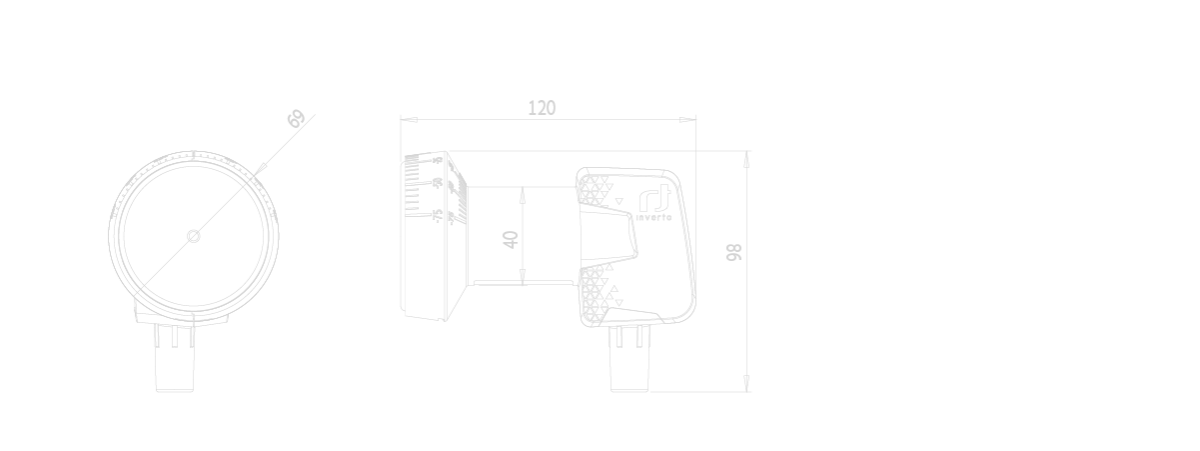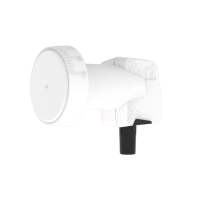Speziell entwickelt um die Nachfrage des globalen DTH-Marktes für wettbewerbsfähige und 4G/LTE geschützte LNBs zu bewältigen. Mit der neuesten Chipsatz-Technologie und dem Wellenleiter-Design bietet dieser LNB optimierte Empfangsmöglichkeiten. Es ermöglicht den Empfang von Satelliten-TV und Radio von einem Satelliten und seine Verteilung zu einer Set-Top Box. Der LNB unterstützt HD- und UHD-Übertragungen, hat hervorragende HF-Werte, einen sehr geringen Stromverbrauch und ist so konzipiert um Interferenzen von 4G/LTE-Signalen optimal zu unterdrücken. Entwickelt und Hergestellt nach den höchsten Qualitätsstandards der Industrie, um den strengen Spezifikationen zu entsprechen, ist dieser LNB eine ideale Lösung für den weltweiten Satelliten-Rundfunkempfang der DTH-Betreiber.
Hauptmerkmale:
- Geringes Phasenrauschen, DVB-S2 (HD und UHD) konform
- Geringes Rauschmaß
- Geringer Stromverbrauch
- Hohe Kreuzpolarisationsunterdrückung
- Hohe Frequenzstabilität
| Technische Daten | |
|---|---|
| Eingangsfrequenzbereich |
10.7 GHz ~ 12.75 GHz |
| Ausgangsfrequenzbereich |
950 MHz ~ 2150 MHz |
| Oszillatorfrequenz (LO) Tiefband |
9.75 GHz |
| Oszillatorfrequenz (LO) Hochband |
10.6 GHz |
| Rauschmaß |
0.3 dB typ. (0.7 dB max.) |
| LO Frequenzgenauigkeit @ 25 °C | ±500 kHz max. |
| LO Temperaturdrift | ±1.0 MHz max. |
| Oszillator (LO) Phasenrauschen (10 kHz) |
-80 dBc/Hz max. |
| Verstärkung |
55 dB min. |
| Verstärkungswelligkeit (innerhalb 26 MHz Bandbreite) |
±0.75 dB |
| Verstärkungsschwankung (im Vollband) |
±4 dB |
| Spiegelfrequenzunterdrückung | 40 dB min. |
| Intermodulationsprodukte 3. Ordnung - ICP3 | 10 dBm min. |
| 1 dB Kompressionspunkt (am Ausgang) |
0 dBm min. |
| Kreuzpolarisationsunterdrückung | 22 dB min. |
| Kontrollsignal Ca (V) |
11.0 V ~ 14.0 V |
| Kontrollsignal Cb (H) |
16.0 V ~ 20.0 V |
| Kontrollsignal Cc (Bandumschaltung) |
22 kHz ±4 kHz , 0.4 V ~ 0.8V pp |
| Ausgang VSWR |
2.5 : 1 |
| Bandinterne Störung |
-60 dBm max. |
| Stromaufnahme |
95 mA |
| Betriebstemperatur |
-30 °C ~ +60 °C |
| Ausgangsimpedanz |
75 Ω |
| Ausgangsanschluss |
F-Typ (w) |
| Antennen F/D Verhältniss |
0.6 |
| Gewicht | 136 g |
| Daten für Logistik | |
| Abmessungen Verpackung (L x B x H) | 13.1 cm x 8.1 cm x 7.6 cm |
| Gewicht Verpackung | 0.182 kg |
| Stückzahl per Karton | 100 pcs |
| Abmessungen Karton (L x B x H) | 67.5 cm x 42.5 cm x 32.5 cm |
| Gewicht Karton | 19.2 kg |
| Stückzahl per Palette | 24 ctns/plt |


Bedienungsanleitung

Bild

Zeichnung

Konformitätserklärung (CE)

Konformitätserklärung (UKCA)

FAQ
Q: Was ist ein LNB?
A:
Die Abkürzung LNB steht für Low Noise Blockkonverter (auch als LNC, Low Noise Converter, abgekürzt). Ein LNB wird für den Empfang der Satellitensignale verwendet und für gewöhnlich in oder an der Satellitenantenne befestigt. Ein LNB sammelt und verstärkt das von der Satellitenantenne empfangene Signal und transformiert es auf eine besser zu handhabbare ZF-Frequenz, die dann über eine standardmäßige Koaxialverkabelung zu den Empfänger geführt wird.
Q: Was ist ein Feedhorn?
A:
Das Feedhorn ist ein Teil vom LNB (auch bekannt als „Hornstrahler“). Es hat die Aufgabe, die von der Schüssel reflektierten Signale einzufangen und diese gegen etwaige Fremdeinstrahlung von anderen Quellen abzuschirmen. Die empfangenen Signale werden an die Antennen- und Verstärkerelektronik innerhalb des LNBs weitergeleitet.
Q: Was ist der Unterschied zwischen einem Quad und Quattro LNB?
A:
Ein Quad oder Quad–Switch LNB ist ein LNB mit 4 unabhängigen Anschlüssen zum Anschluss von 4 Receivern. Der Multischalter ist dabei integriert. In der Regel werden die Anschlüsse eines Quad LNBs auch nicht beschriftet da man an jeden beliebigen Ausgang ein STB oder Fernseher mit Satellitenreceiver anschliessen kann.
Ein Quattro LNB hat 4 verschiedene Anschlüsse ohne eingebauten Multischalter. Horizontal und vertikal polarisierte Signale werden jeweils getrennt für Lowband und Highband herausgeführt. Über einen nachgeschalteten Multischalter kann dann eine Verteilung an nahezu beliebig viele Satellitenreceiver erfolgen. Alle vier Ausgänge eines Quattro LNBs sind entsprechend mit V/L, V/H, H/L und H/H beschriftet, um eine Verwechslung und Fehlfunktionen beim Anschluss an einen Multischalter zu vermeiden.
Q: Was bedeutet HsQuare Technologie?
A:
HsQuare ist eine einzigartige Hohlleitertechnologie, gekoppelt mit einem etwas größerem Feed-Horn-Design, um bessere HF-Leistungen im Vergleich zu herkömmlichen kreisförmigen Mikrowellenleitern zu liefern.
Q: Was ist ein Monoblock LNB?
A:
Ein Monoblock LNB ist ein LNB, das den Empfang mehrerer Satelliten auf meist benachbarten Orbitpositionen mit einer feststehenden Satellitenantenne ermöglicht. Der Monoblock LNB besteht aus zwei unabhängigen LNBs, die in ein Gehäuse integriert sind. Die Umschaltung zwischen den Orbitpositionen erfolgt über DiSEqC Signale oder Toneburst (Mini DiSEqC). Für Europa gibt es z. B. Monoblock LNBs als Single, Twin und Quad LNBs mit ca. 6° Abstand für den Empfang der Ku-Band-Frequenzen von ASTRA 1 (19,2° Ost) und Hotbird (13° Ost) oder mit 4,3° Abstand für den Empfang von ASTRA 1 (19,2° Ost) und ASTRA 3 (23,5° Ost).
Q: Warum kann ich nur einen Satelliten mit meinem Monoblock LNB empfangen?
A:
Monoblock LNBs sind für eine bestimmte Antennengröße (z.B. 80cm) ausgelegt. Wenn Ihre Satellitenschüssel zu klein ist (z. B. 70cm) oder zu groß (z. B. 90cm), ist es nicht möglich, beide Satellitensignale gleichzeitig auf die jeweiligen LNB-Feedhorns zu fokussieren. Bitte wählen Sie die Antennengröße für die ihr Monoblock LNB entworfen wurde.
Für den doppelten Satellitenempfang sollte die Satellitenantenne zuerst auf das schwächere Signal der beiden Satelliten ausgerichtet werden. Danach kann eine leichte Anpassung vorgenommen werden, um den bestmöglichen Empfang von beiden Satelliten zu gewährleisten. Eine Monoblock-Installation erfordert eine etwas größere Anntenneschale als wenn nur eine Satellitenposition gewünscht wird. Monoblock LNBs sind so konzipiert, dass sie an einer bestimmten Schalengröße optimal arbeiten und es ist wichtig, dass die richtige Schalengröße installiert ist um einen zuverlässigen Empfang zu gewährleisten.
Bei der Installation empfehlen wir zudem den LNB am Feedhorn für Satellitenpostion „A“ am LNB Halter zu befestigen (Beispiel für Monoblock mit zwei Feedhörnern). Dann die Satellitenschüssel optimal für diese Position ausrichten. Danach Signalqualität von Satellitenposition „B“ überprüfen und eventuell Antennenausrichtung nochmals optimieren. In den meisten Monoblockkonfigurationen ist z. B. Hotbird (13° Ost) auf Satellitenposition „A“ und ASTRA 1 (19,2° Ost) auf Satellitenposition „B“. Vergewissern Sie sich vor der Installation ob dies bei Ihrem Monoblock LNB so ist und überprüfen Sie die Einstellungen an Ihrem STB oder Fernseher, gegebenfalls müssen diese angepasst werden. Weitere Information zu den Belegungen bzw. Zuweisungen der Satellitenpositionen finden Sie in den entsprechenden Bedienungsanleitungen.
Q: Was ist ein Wideband LNB?
A:
Mit einem Wideband-LNB, welches nur einen Lokaloszillator (z.B. 10,4GHz) hat, steht an nur zwei Ausgängen das gesamte Frequenzspektrum des Satelliten zur Verfügung (300MHz bis 2350MHz). Ein Ausgang führt alle vertikal polarisierten Signale, während der zweite Ausgang alle horizontal polarisierten Ausgänge trägt. Während die meisten der derzeitigen Multischalter, bzw. Receiver auf dem Markt keinen Breitbandeingang akzeptieren, können Multischalter wie neuere Unicable-Switches diese Signale als Eingabe akzeptieren.
Q: Was bedeutet Unicable?
A:
Unicable ist ein neues Verfahren zur Verteilung von Satellitensignalen. Dabei können mehrere Receiver (aktuell laut Norm EN 50607 maximal 32) an nur eine einzige Ableitung angeschlossen werden, was bei einer konventionellen Satblock-Verteilung (Sternverteilung im Multischalter-Betrieb) nicht möglich ist. Weitere Information zu Unicable finden sie unter www.inverto.tv/what-is-unicable-2


